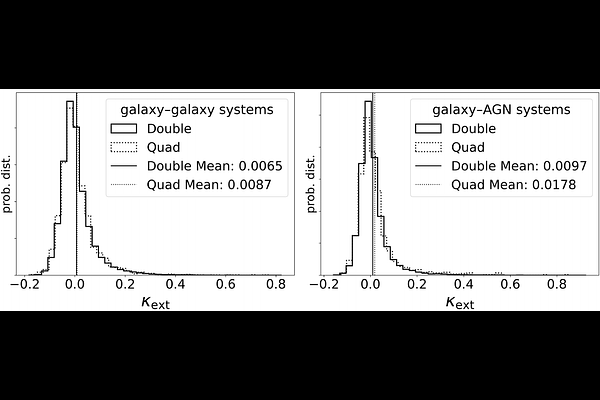Analyzing Line-of-sight selection biases in galaxy-scale strong lensing with external convergence and shear

Analyzing Line-of-sight selection biases in galaxy-scale strong lensing with external convergence and shear
Xianzhe TZ Tang, Simon Birrer, Anowar J. Shajib, Narayan Khadka, the LSST Strong Gravitational Lensing Science Collaboration, the LSST Dark Energy Science Collaboration
AbstractThe upcoming Vera Rubin Observatory Legacy Survey of Space and Time (LSST) will dramatically increase the number of strong gravitational lensing systems, requiring precise modeling of line-of-sight (LOS) effects to mitigate biases in lensing observations and cosmological inferences. We develop a method to construct joint distributions of external convergence ($\kappa_{\mathrm{ext}}$) and shear ($\gamma_{\mathrm{ext}}$) for strong lensing LOS by aggregating large-scale structure simulations with high-resolution halo renderings and non-linear correction. Our approach captures both smooth background matter and perturbations from halos, enabling accurate modeling of LOS effects. We apply non-linear LOS corrections to $\kappa_{\mathrm{ext}}$ and $\gamma_{\mathrm{ext}}$ that address the non-additive lensing effects caused by objects along the LOS in strong lensing. We find that, with a minimum image separation of $1.0^{\prime\prime}$, non-linear LOS correction due to the presence of a dominant deflector slightly increases the ratio of quadruple to double lenses; this non-linear LOS correction also introduces systematic biases of $\sim 0.1\%$ for galaxy-AGN lenses in the inferred Hubble constant ($H_0$) if not accounted for. We also observe a $0.66\%$ bias for galaxy-galaxy lenses on $H_0$, and even larger biases up to $1.02\%$ for galaxy-AGN systems if LOS effects are not accounted for. These results highlight the importance of LOS for precision cosmology. The publicly available code and datasets provide tools for incorporating LOS effects in future analyses.